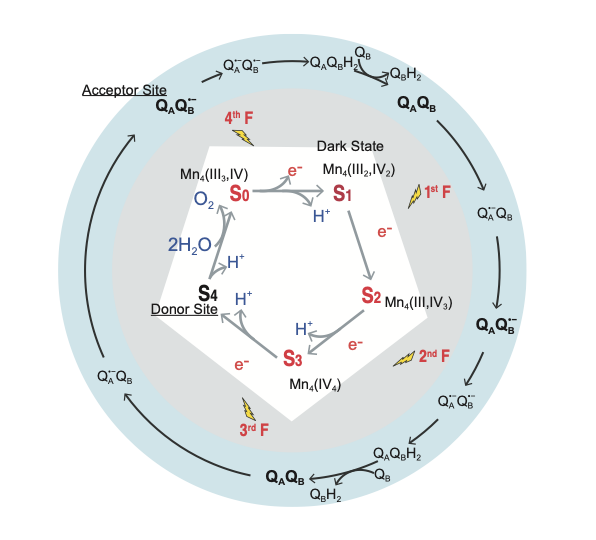Superfacility Framework Advances Photosynthesis Research
http://www.es.net/news-and-publications/esnet-news/2019/superfacility-framework-advances-photosynthesis-research/
Superfacility Framework Advances Photosynthesis Research
Integrating experimental instruments with high-speed networking and computational resources yields real-time feedback
May 3, 2019
Keri Troutman, khtroutman@lbl.gov, 510-486-5071

The PSII water oxidation process.
For more than a decade, a team of international researchers led by Berkeley Lab bioscientists has been studying Photosystem II (PSII), a protein complex in green plants, algae, and cyanobacteria that plays a crucial role in photosynthesis. They’re now moving more quickly toward an understanding of this three-billion-year-old biological system, thanks to an integrated superfacility framework of experimental instrumentation with computational and data facilities. PSII researchers working at the SLAC National Accelerator Laboratory’s Linac Coherent Light Source (LCLS) recently began using the Energy Sciences Network (ESnet) at Lawrence Berkeley National Laboratory (Berkeley Lab) to enable real-time processing of experimental data at the National Energy Research Scientific Computing Center (NERSC).
PSII is the only known biological system able to harness sunlight for the oxidation of water into molecular oxygen. Scientists have been seeking an atomic-scale understanding of how PSII splits a water molecule during photosynthesis for decades now. This key understanding would help advance the development of artificial photosynthesis, a promising source of abundant and clean energy.
To gain insight into how PSII works the research team, which is led by Berkeley Lab bioscientists Vittal Yachandra, Junko Yano, and Jan Kern, uses X-ray free electron lasers (XFELs) at LCLS to capture images of PSII throughout the stages of its reaction cycle. At the core of PSII is an oxygen evolving complex (OEC; Mn4CaO5) that, when energized by solar photons, catalyzes a four photon-step cycle of oxidation states that ultimately yields molecular oxygen. Using XFELs to study the protein complex at specific time points in between each cycle helps them understand structural changes in PSII, consequently understanding the mechanism of bond formation between two oxygen atoms.

Representative electron density difference maps from PSII experiments showing critical structural features showing up with the progress of the reaction.
Historically, the ability to capture these images has been hindered by the fact that most X-ray crystallography technology destroys the samples before meaningful data can be collected. Scientists need to observe X-ray diffraction of the intact Mn4CaO5 complex in action, but the molecule is highly sensitive to radiation. However, the advent of XFELs and sophisticated data processing methods have changed this; last year researchers were able to capture the most complete and highest-resolution picture to date of PSII (the results were published in
Nature in 2018).
…

